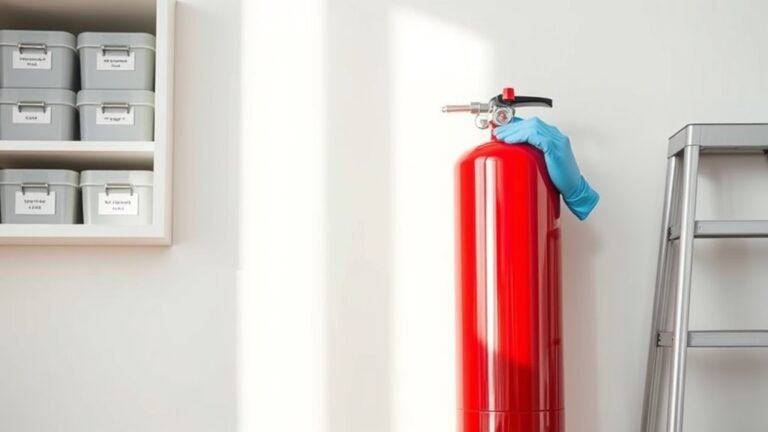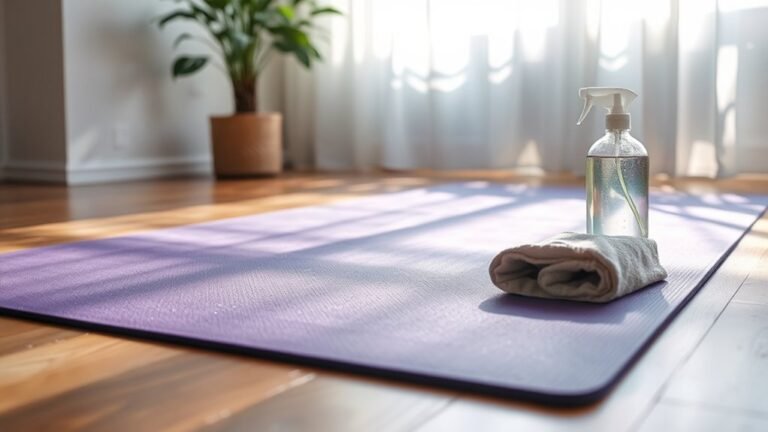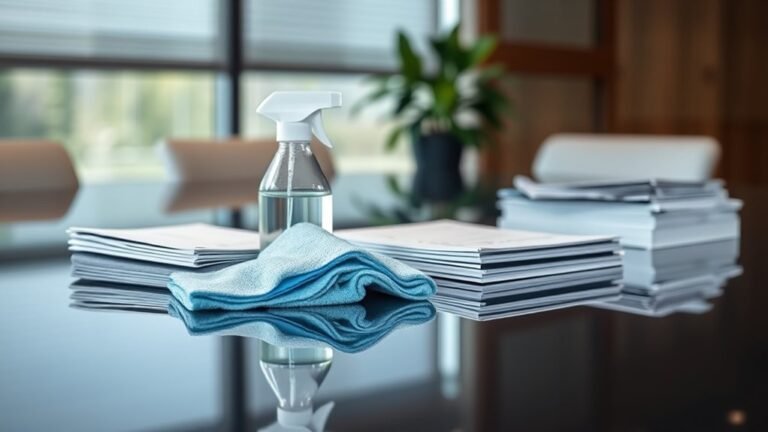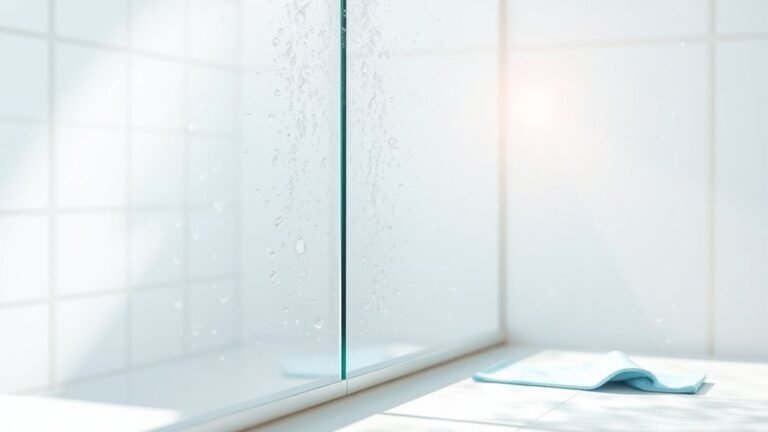How to Clean and Polish Concrete Countertops
To clean and polish your concrete countertops, start by clearing the surface and using a soft cloth with a pH-neutral cleaner to gently wipe away dirt. Rinse with warm water and dry to prevent spots. For stains, act quickly and try a baking soda poultice. When polishing, apply a thin, even layer with a soft cloth, then buff for a smooth, glossy finish. Keep up regular cleaning and sealing to protect and maintain their beauty. There’s more to guarantee your countertops stay stunning over time.
Understanding the Nature of Concrete Countertops
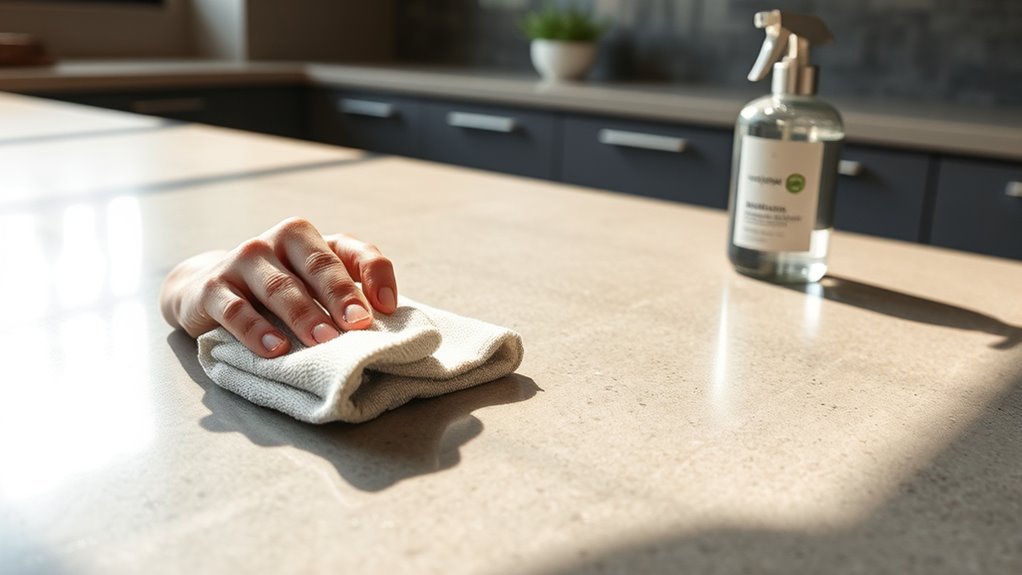
Concrete countertops are durable and unique, but they require special care because of their porous nature. Understanding concrete properties helps you appreciate why these surfaces stand out—they combine strength with a natural, raw beauty. The countertop durability you get with concrete means it can handle everyday use, but its porous surface can absorb spills and stains if left unsealed. This porous quality demands regular maintenance to keep your countertop looking fresh and lasting longer. By recognizing these concrete properties, you gain the freedom to enjoy a rugged, stylish kitchen surface without worrying about damage. Treating your concrete countertop with the right knowledge empowers you to maintain its durability while embracing its distinctive charm.
Gathering the Right Cleaning Supplies
Knowing how porous your countertop is means you’ll want to choose cleaning supplies that protect its surface without causing damage. You deserve cleaning tools that work effectively while respecting your space and the planet. Opting for eco friendly options not only safeguards your countertop but also aligns with a lifestyle of freedom and responsibility. Here’s what you’ll need to gather before you start:
Choose eco-friendly cleaning tools that protect your countertop while respecting your home and the planet.
- Soft microfiber cloths for gentle wiping
- pH-neutral, biodegradable cleaner to avoid harsh chemicals
- A soft-bristled brush for stubborn spots
- Warm water for rinsing without residue
- Natural stone sealer to maintain protection
Preparing the Countertop for Cleaning

Before you start cleaning, you’ll want to clear the countertop of any items and debris to guarantee an unobstructed surface. This step is essential for proper countertop preparation, allowing you to work efficiently without missing any spots. Make certain to remove everything, including small crumbs or dust, so you can fully assess the condition of your concrete countertop.
Next, consider cleaning safety. Wear gloves to protect your skin from harsh cleaners or abrasive materials. If you’re using chemical cleaners, confirm the area is well-ventilated to avoid inhaling fumes. Taking these precautions lets you clean confidently and freely without worry. Proper preparation sets the stage for a thorough cleaning, making the process smoother and more effective.
Step-by-Step Cleaning Process
Once your countertop is cleared and you’re properly protected, you can begin the cleaning steps. Keeping a consistent cleaning frequency is key to maintaining your concrete countertop durability and freedom from buildup. Here’s how to tackle it efficiently:
Clear your countertop and protect yourself before starting regular cleaning to maintain its durability and prevent buildup.
- Use a soft cloth or sponge with mild soap and warm water.
- Gently scrub the surface to avoid scratches.
- Rinse thoroughly with clean water to remove residue.
- Dry the countertop with a microfiber cloth to prevent water spots.
- Repeat this process regularly, ideally once a week, to keep your countertop looking fresh.
Removing Stains and Spots Effectively

When stains or spots appear on your concrete countertop, the first step is to identify what caused them. You’ll want to use cleaners that are safe for concrete to avoid damage. Next, applying the right stain removal techniques will help restore your countertop’s look effectively.
Identifying Common Stains
Although concrete countertops are durable, they can still develop stains from everyday use. Recognizing these common stains helps you tackle them quickly and keep your surfaces looking fresh. Here are some typical culprits you might encounter:
- Oil stains from cooking oils or dressings that seep into pores
- Food stains like tomato sauce or coffee that leave discoloration
- Rust spots caused by metal items left wet on the surface
- Ink marks from pens or markers that accidentally touch the countertop
- Wine spills that can soak in and stain deeply
- Water rings from glasses or wet containers resting too long
Identifying these stains early gives you the freedom to act fast and maintain your concrete countertops’ natural beauty without hassle.
Choosing Safe Cleaners
Because concrete is porous and can be sensitive to harsh chemicals, you’ll want to choose cleaners that effectively remove stains without damaging the surface. Opt for eco friendly options that protect both your countertop and the environment. Non toxic alternatives, like gentle vinegar solutions or mild dish soap mixed with water, offer safe yet powerful cleaning without harmful residues. Avoid acidic or abrasive cleaners, as they can erode or dull the concrete over time. Sticking with these safe cleaners lets you maintain your countertop’s beauty while keeping your space healthy and free. By choosing wisely, you gain freedom from harsh chemicals and the worry of damage, making your cleaning routine both effective and responsible.
Stain Removal Techniques
A stained concrete countertop doesn’t have to mean permanent damage. Understanding stain absorption characteristics will help you tackle spots effectively while embracing stain prevention methods for lasting beauty. Here’s how to remove stains without losing your freedom to enjoy your space:
- Act quickly to blot spills instead of wiping, preventing deeper absorption.
- Use a poultice made from baking soda and water to lift stubborn stains gently.
- Apply a gentle, pH-neutral cleaner to avoid harming the concrete surface.
- For oil stains, try a degreaser specifically designed for concrete.
- Reseal your countertop regularly to enhance stain resistance and ease future cleaning.
Choosing the Appropriate Polish for Concrete
When choosing a polish for your concrete countertop, you’ll want to contemplate the type that best suits your surface and lifestyle. Factors like finish preference and durability play a big role in making the right choice. I’ll also share some application tips to help you get a smooth, lasting shine.
Types of Concrete Polish
Choosing the right polish for your concrete countertops can make all the difference in both appearance and durability. You’ve got options, and picking the one that fits your lifestyle and desired finish is key. There are two main techniques: wet polishing, which uses water to reduce dust and cool the surface, and dry polishing, which is quicker but creates more dust. Beyond that, different polish types offer various protective qualities and finishes.
Here’s a quick look at common types:
- Acrylic-based polish for a glossy, water-resistant finish
- Epoxy polish for heavy-duty protection
- Polyurethane polish for flexibility and durability
- Wax polish for a natural sheen and easy touch-ups
- Penetrating sealers that strengthen from within without changing the look
Choose what suits your freedom to maintain and enjoy your space.
Factors Influencing Polish Choice
Understanding the factors that influence your polish choice will help you get the best results for your concrete countertops. First, consider the surface texture—smooth surfaces often need a different polish than rough or porous ones to achieve an even shine. You’ll also want to think about polish durability; some polishes hold up better against daily wear, stains, and moisture. If your countertop gets heavy use, choose a polish designed to last longer without frequent reapplication. Also, factor in the finish you want—matte, satin, or glossy—as some polishes accentuate the natural look of concrete better than others. By paying attention to these elements, you’ll pick a polish that not only looks great but also protects your countertops, giving you freedom from constant upkeep.
Application Techniques and Tips
Applying the right polish to your concrete countertops involves a few key steps to guarantee a smooth, durable finish. Choosing the appropriate polish means considering the surface texture and how you’ll apply it. Different application methods affect the outcome, so mastering polishing techniques is essential for lasting results. You want freedom to customize your space without worrying about wear or dullness.
Keep these tips in mind:
- Use a soft cloth or foam applicator for even coverage
- Work in small sections to avoid drying before buffing
- Apply thin, consistent layers to prevent buildup
- Buff with a high-speed polisher for a glossy finish
- Allow proper drying time between coats for durability
Applying Polish for a Smooth Finish
To achieve a smooth finish on your concrete countertops, you’ll need to carefully apply a quality polish that enhances both durability and shine. Start by choosing a polish designed specifically for concrete surfaces. Apply it evenly with a soft cloth or buffer, moving in circular motions to guarantee full coverage. The polish application should be thin but thorough—this helps avoid streaks and promotes a consistent countertop shine. Allow the polish to dry completely before touching the surface, as premature contact can mar the finish. Remember, this step isn’t just about looks; it seals and protects your countertop, giving you the freedom to enjoy a sleek, resilient surface without constant worry. Take your time here—precision in polish application is key to that flawless, smooth finish you want.
Maintaining and Protecting Your Countertops Regularly
Once you’ve polished your concrete countertops to a smooth finish, keeping them looking great requires regular care and protection. Regular maintenance and preventive measures will extend their lifespan and preserve their beauty without tying you down.
Polished concrete countertops stay beautiful with simple, regular care and smart protection.
To maintain and protect your countertops, consider these tips:
- Clean spills immediately to prevent stains.
- Use cutting boards and trivets to avoid scratches and heat damage.
- Apply a quality sealer every 1-3 years based on use.
- Wipe surfaces daily with a pH-neutral cleaner to avoid dullness.
- Avoid harsh chemicals that can degrade the finish.
Frequently Asked Questions
Can Concrete Countertops Be Repaired if They Crack?
Cracks in concrete countertops aren’t the end of the road—they’re just bumps on your freedom journey! You can definitely handle crack repair yourself or with a pro’s help, keeping your surface strong and stylish. Regular concrete maintenance, like sealing and filling chips, lets you keep control and avoid bigger issues. So don’t worry, you’ve got the power to restore your countertop’s beauty and enjoy your space without limits.
How Long Does Polished Concrete Countertop Last?
You’ll love the lifetime durability polished concrete countertops offer—they can last decades with proper care. To keep yours looking fresh and strong, follow simple maintenance tips like sealing regularly, wiping spills promptly, and avoiding harsh chemicals. This way, you’re free to enjoy their beauty and resilience without worry. With just a bit of upkeep, your polished concrete will stay stunning and durable, fitting perfectly into your lifestyle.
Are Concrete Countertops Heat Resistant?
Oh sure, go ahead and place that blazing hot pan right on your concrete countertop—because it’s basically a superhero when it comes to heat resistance, right? Well, not exactly. While concrete is more heat resistant than some materials, it’s not invincible. You’ll still want to practice smart countertop maintenance to avoid cracks or discoloration. So, enjoy your freedom but respect the limits; a trivet isn’t just a suggestion—it’s your countertop’s best friend.
What Is the Cost Range for Installing Concrete Countertops?
When you’re considering concrete countertops, installation expenses can vary quite a bit depending on your material choices and customization level. Typically, you’re looking at anywhere from $65 to $135 per square foot, including labor and materials. If you want added design freedom, like unique colors or embedded objects, expect costs to rise. Remember, with concrete, you’re paying for durability and a personalized look that’s hard to beat.
Can Concrete Countertops Be Customized With Colors or Patterns?
Funny you ask about customization because concrete countertops are like a blank canvas—you’ve got endless color choices to match your vibe. You can mix pigments right into the concrete for bold shades or use stains afterward for subtle hues. Pattern techniques like scoring, stenciling, or embedding materials let you create unique designs that feel totally you. If you want freedom in your kitchen style, concrete countertops let you express it in every inch.

